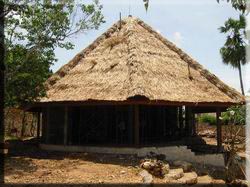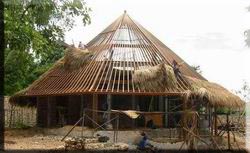Thatched Roofing


Balinese Alang Alang Thatched Roofing for Export
Traditional alang alang construction
Alang alang thatching has been used in Indonesia for hundreds of years on the islands of Bali, Lombok, Sumbawa, Timor and Sumba as a traditional system of roofing. There are slight variations in the application of the material throughout these different places but by far the neatest and strongest form is found in Bali.
The blades of alang alang thatching are constructed from the grass Imperata Cylindrica which is called locally ambongan. It is also called alang in Indonesian and Malay. It is known in Australia as bladey grass because of its tendency to cut skin. It is a tough and resilient grass and grows best in harsh conditions and poor ground. Some of the strongest examples are found on sandy margins at the edge of beaches and on cliff tops. Because of the demand for alang alang for tourism projects in Bali and the loss of the beachfront margin to hotels, there has been a lot of grass production in fertile soils that were normally used for other farming, also using fertilizer to allow faster harvesting. The alang alang made from this raw material is inferior which shortens the lifespan of the roof material.
Traditionally, the batten used to form the spine for the pieces that are laid onto the roof was a strong, small diameter bamboo, but because of the difficulty getting supplies of this material the practice now is to use split pieces of larger bamboo. This change has affected the form of the blades of grass as they wrap around the batten, causing right angles rather than a smooth curve. This also shortens the lifespan of the roof material and also produces an unattractive, irregular and untidy finish. In addition, and most importantly, this split bamboo is very prone to insect attack as it still has a lot of bulky cellulose that is exposed by splitting the bamboo.
Currently, the fabrication of each length of alang alang is still done in the same traditional way as before. The worker selects a bunch of grass approximately one meter long and wraps 150 mm of the base of the bundle over the batten. A small split bamboo is laid about 50 mm down from the batten, parallel to the batten and at right angles to the blades of grass and the bundles of grass are progressively lashed to this using a continuous length of either black ijuk twine or twine made from bamboo. The traditional length of one piece of alang alang is three meters.
Balinese roofs are commonly, but not always, made with bamboo rafters. The alternative is timber which is more expensive. The rafters for alang alang roofs have additional short rafters, set at a lower pitch, overlapping the bottom end of the main rafter. This creates a slight upward lift to the roof at the eaves. Both the main rafter and this additional rafter are finished with a bamboo or wood fascia. When sufficient alang alang has been made to complete the roof, if the rafters are bamboo, it is lashed in place, starting at the bottom of the rafter near the outer fascia. It is lashed with fine bamboo at every rafter using a tucked twist as a knot. They cannot nail it as the bamboo rafters would split The alang alang is then progressively placed all the way up until the ridge. The spacing from the fascia to the lintel is tight, approximately 40mm, and then from the lintel to the peak or ridge there is approximately 50mm spacing. Timber rafters can also use lashed bamboo if the lower edge of the rafter has a radius.
If there are hips these are also finished using the same grass. A bamboo pole as long as the hip has alang alang tied to its end in a similar fashion as a broom. This is then lashed or nailed to the timber hip so that the bamboo pole does not protrude beyond the outer fascia. Small bundles of alang alang are then lashed and spiked with bamboo nails to the “broom stick” progressing from the eave to the top, forming a big roll over the top of the hip.
The ridge or peak of the roof is then finished with decorative terracotta capping pieces. The drooping eaves are then cut horizontally to create the traditional Balinese roof. In Lombok and Sumbawa there is the same cut finish. In Sumba and Timor the alang alang is left uncut, with the grass drooping down, “Tahitian style”.
The alang alang roof is good insulation against heat and is very attractive to look at, both inside and out. It is durable, with reports of it lasting to twenty years, although by this time it would be very thin and unattractive. More commonly it has a life span of seven or eight years.
The actual life span depends on many factors. An alang alang roof, as it is made from organic materials, is constantly under a process of decomposition. Modern Balinese roofs that we have documented have lasted from between seven and fifteen years. The factors that have affected these periods of time are the quality and quantity of material used to fabricate the original elements, the pitch of the roof, wind damage, whether there is water from an upper roof falling on it and whether there is overhanging trees that both drop leaves and prevent the outer surface from drying during sustained periods of rain.
The only nrgative comment made about alang roofs in Bali is the amount of dust from the small insects that have their life cycle in the bamboo rafters and the battens that form the spines of each individual piece of alang alang.. There is very little dust, however, from the inner surface of the alang alang as it is not attacked by insects and is hardly decomposing.
PT Bale Gede Internasional took this factor into consideration and developed an improved form of alang alang.
PT Balegede Internasional’s improved alang alang construction for export
Mark Keatinge of PT Bale Gede Internasional has been working with alang alang since 1973 and has spent a great deal of time working to create a product that maximises the life span and is more suitable for export yet still retains alang alang’s unique style and character.
Our export buildings contain no bamboo for structural elements. This is because of the difficulties encountered with insect attack and splitting.
Our alang alang is produced by our own workers from carefully selected grass grown naturally in the correct locations. We obtain it from diverse locations all over the Eastern archipelago and personally supervise its harvesting and drying. Each constructed piece is two meters long to make container shipping more practical.
We have replaced the bamboo batten used for the spine with a PVC pipe which provides the smooth circular fold that is not seen in the normal modern local product and also solves the problem of insect attack and the subsequent dust. A treated bamboo insert strengthens the pipe and also provides a very neat way to join adjacent lengths. The PVC pipe also follows a curve more freely than bamboo for circular buildings. The overall finish is much cleaner and many comments have been made by Balinese about the quality of our export work. This PVC batten also allows the alang alang to be nailed or screwed by local workers on site. The method of tying the alang alang that the Balinese use, although it looks simple to the observer, is in fact an art learnt from childhood and we have yet to see non-Balinese (even Javanese) produce a satisfactory result. In addition, nailing or screwing the alang alang is performed from the top (tieing must be done from below), reducing onsite labour and equipment costs and reducing the time needed to roof the building.
The hip coverings provided by us are totally prefabricated and simply screw onto the hip timber. They also use a PVC pipe of a larger diameter.
Alang alang roofs require no finishing or maintenance but a spraying with a varnish of the inside can enhance their appearance.






